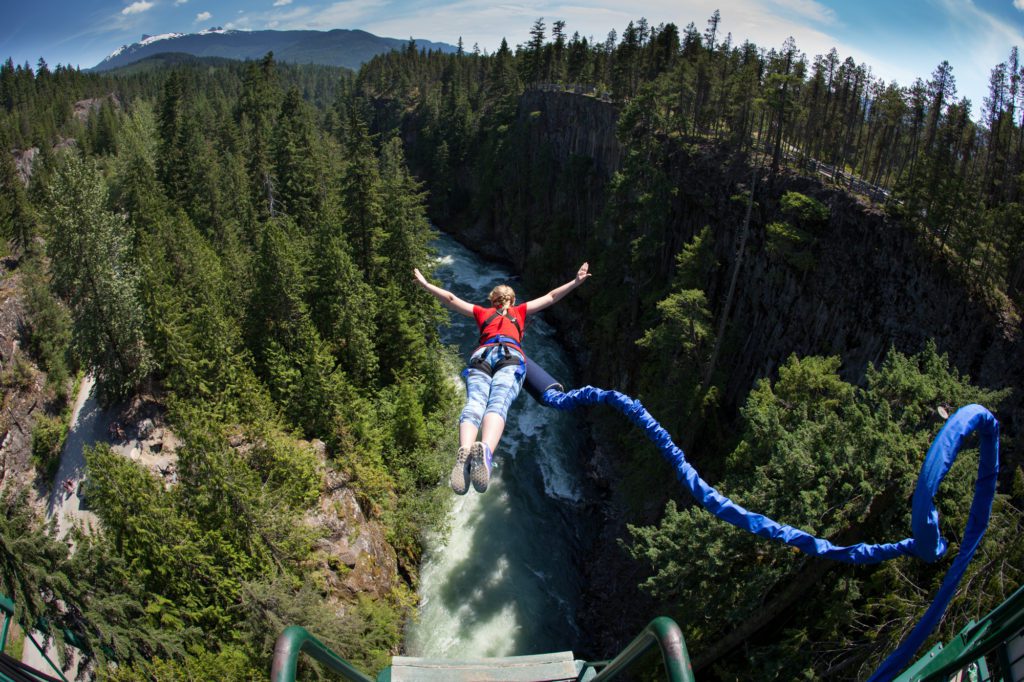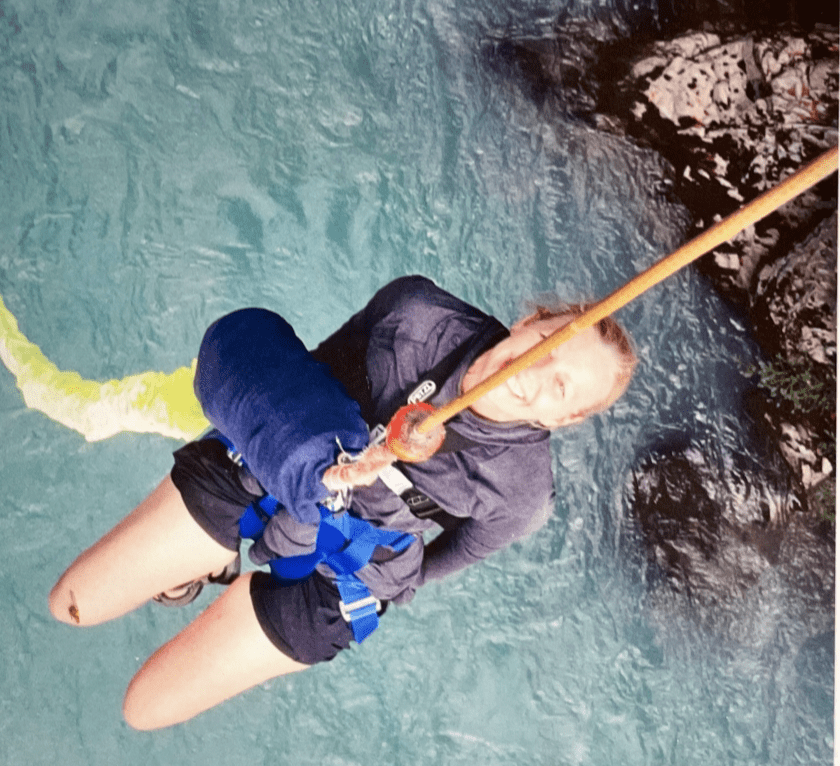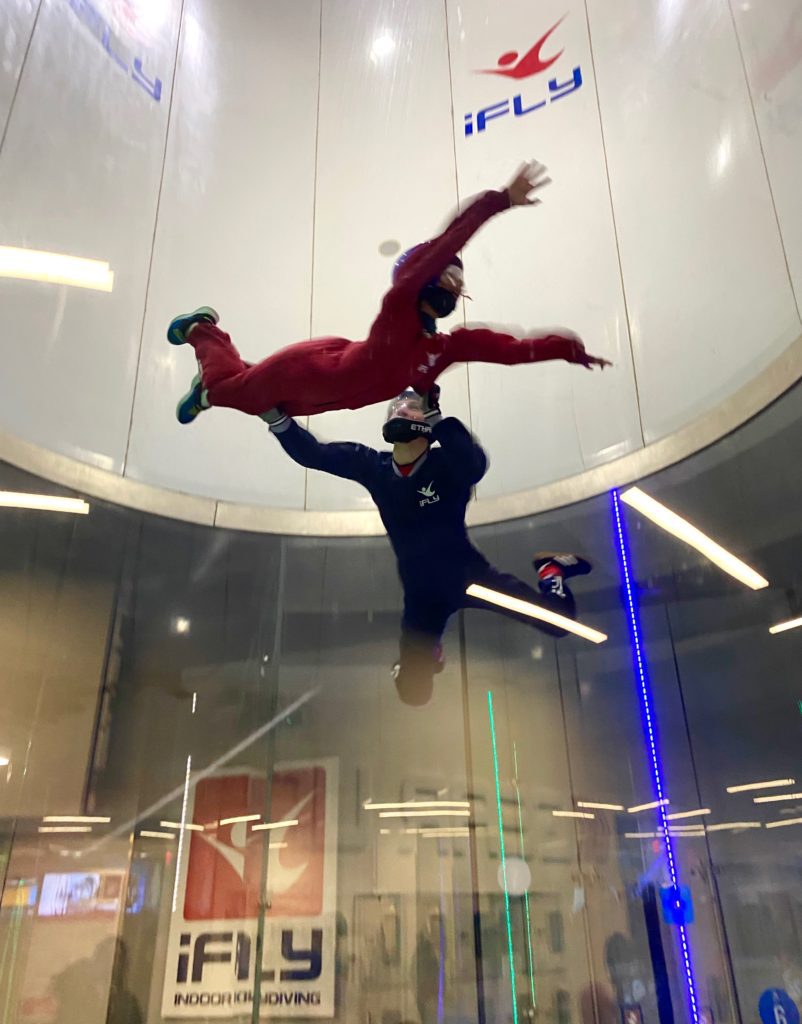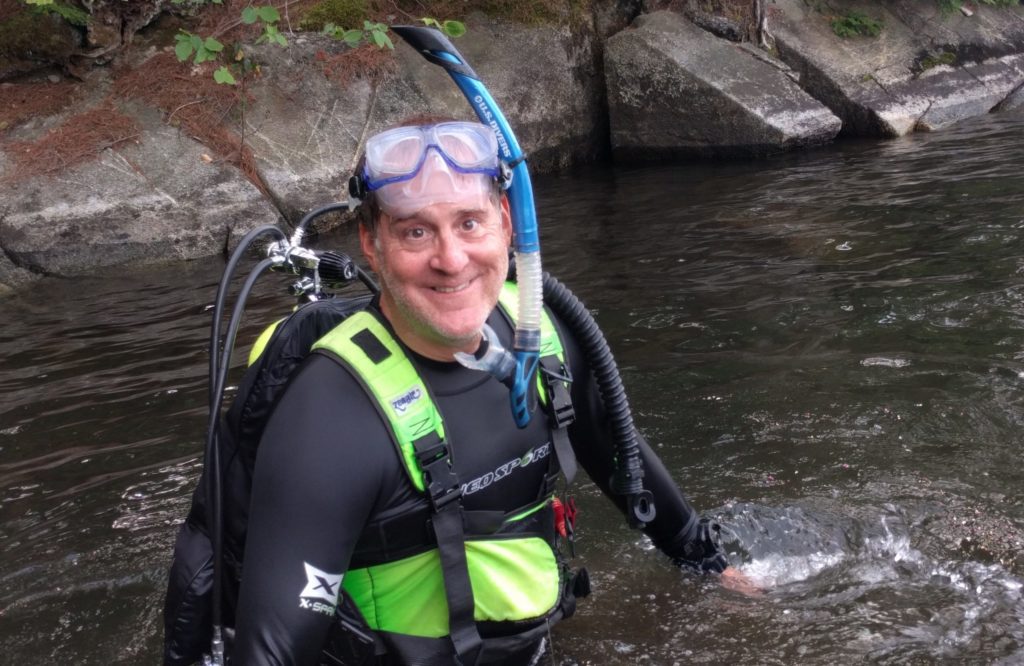The Sky’s the Limit!: Pushing Our Boundaries
By • January 12, 2022 0 1851

With the new year much on our minds and a whole new crop of freshly-resolved new year’s resolutions, the staff of The Georgetowner opted to explore the concepts of “stepping out of one’s comfort zone” and “pushing one’s boundaries” for our January issue. Rest assured, the very process required us to think about our fears, our challenges, our thrills and our senses of purpose.
When it comes to challenging one’s limits, everyone has their own starting points, phobias and enjoyability thresholds, so it’s no surprise that our recollections and reflections covered a wide range of topics and experiences – from high flying, to free-falling, to fast moving, to self-improving and to re-connecting.
With so many troubles in our world, we hope these stories inspire you to think of the many opportunities the new year offers for fresh starts and rejuvenation.
Whistling in the Wind
By Robert Devaney, editor-in-chief
Up in the air about pushing boundaries? In more ways than one, says publisher Sonya Bernhardt, willing to try anything once.
“I don’t mind getting out of my comfort zone,” she says. “I’m kind of a daring person, I think.”
She has the proof, having broken a few bones over the years, biking, running or just tripping. For someone who ran the Army 10-Miler 12 years ago and walked the Camino de Santiago four months ago, adventure is always on her to-do list.
There was bungee jumping in British Columbia in 2015. “I’m scared of heights,” Bernhardt remarks. “I didn’t want to do it, but I wanted to overcome my fear.” She saw people before her jumping and how it was all under control, held her breath and — with her husband’s pushing — took the plunge. “Jumping off the bridge was exhilarating. It happened so fast, but the thrill of it stays in your skin.”

Sonya bungee jumping in British Columbia.
During Christmas week, she tried motored paragliding — or paramotoring — over Amelia Island in Florida. “It was pretty scary getting on a thing so little with such a small motor, but the pilot was a real pro,” she says. “The experience is closest to being a bird. We flew over our house, over land and then over the Atlantic. I saw schools of hammerheads and stingrays and then dolphins.” From that vantage place, she adds, “You’re in awe of the planet Earth — it’s a busy place.”
Ever curious, this adventure traveler loves nature and getting close to it. “I guess I’m a living-on-the-edge kind of girl,” Bernhardt says. “After all, I do own a newspaper. Now, that’s daring, these days. Being an entrepreneur, being a business owner is daring. That’s pushing boundaries, too, every day.”
Weekend Results in Humility
By Chris Jones
Our graphic designer, Troy Riemer of Red Clay Creative, recalled a weekend he spent in West Virginia with friends a few years ago devoted to pushing one’s boundaries. While his whitewater rafting and cliff rappelling experiences in the New River Gorge those two days were quite harrowing, they also taught him some valuable life lessons.
“I actually don’t like rock climbing,” Riemer told us. “But, I kind of like pushing the boundaries of my own fears. I’m afraid of heights.” But, when some guys he had never met, “who were just drinking some beers” near a cliff precipice, asked Riemer and a friend if they’d like to try rappelling down a 200-foot cliff wall, he thought it was worth confronting his acrophobia. So, they went for it.
“It was pretty scary,” Riemer recalled. Hanging off the cliff face and looking over the valley, his rappelling partner asked “isn’t this so beautiful?” But, Riemer said, “It is, but I just want to get down to the ground.” With a laugh, Riemer remembered descending so rapidly he burned his hands on the climbing ropes.
Later, Riemer and his friends went whitewater rafting in rapids that were “classified-plus,” meaning straight-up dangerous. Riemer was sitting in the back of the raft when his group was [intentionally] shooting a 14-foot waterfall as rapidly as possible so they could maneuver their raft up a rock after the drop. Unfortunately for Riemer, he was bounced into the water upon impact. Because it’s all such a blur in his memory, he can’t recall anything from going overboard beyond being relieved to be hoisted back into the raft. Once back on the vessel, he remembers thinking, “This has been the scariest weekend of my life.”
Despite the harrowing experiences, however, Riemer found himself gaining humility from these boundary-pushing experiences. “I mean, I was pretty grateful that a lot of worse things didn’t happen. You know, you hear a lot of horror stories…, but I was like, ‘okay, I made it out and I was thankful.’ You know, sometimes you feel like you have this shield around you and you kind of feel invincible to some degree really. But those moments were very humbling… I would say that it’s worth pushing those boundaries at least once in your life. Afterwards, you can say ‘at least I tried it.’”
Undaunted, Riemer is pursuing his pilot’s license. At higher altitudes, he said, the heights don’t feel as “tangible,” but when the wind currents rock the small plane, “that’s the scary part.”
Learning to Fly (Indoors)
By Christopher Jones, managing editor
When New Year’s rolls around, it’s easy to fall back on all the perennial life-affirming resolutions: to communicate better, exercise more, improve our sleep, eat a healthier diet, learn Sanskrit – you know the deal. More often than not, however, we have difficulty following through on our solemn avowals. By year’s end we simply sip our Champagne and gamely give it another go.
This year, however, I had the good fortune of succeeding with a personally challenging and thrilling endeavor. When the staff of The Georgetowner decided to explore the concept of “pushing one’s boundaries” for our first issue of 2022, I decided to put my vertigo-inducing, knee-wobbling fear of heights to the test and try my hand at skydiving.
Indoors, that is. To see how scary the experience might be – and for the sake of journalism – I gave indoor skydiving (aka “bodyflight”) a shot.
About a half-hour’s drive from Georgetown and two miles from Shady Grove Metro, the iFLY (Montgomery) indoor skydiving complex located at 9400 Gaither Road, Maryland, looks imposing and industrial from the outside as it looms above Interstate 270 – the multi-story building suggestive of a hangar at Cape Canaveral houses a 67-foot tall, 14-foot diameter vertical wind tunnel to lift participants aloft – but on the inside the iFLY program is quite welcoming for newcomers who want to experience “free-fall” in a safe environment.
iFLY invites anyone from “ages 3 to 103” to “defy gravity and experience bodyflight… taught by highly trained, certified coaches.” As long as participants don’t exceed the 300-pound weight limit (beyond the capacity of the wind tunnel’s four 350-horsepower fans and patented air compression and circulation features). And, as long as they don’t have risky medical conditions, and are over 40 inches tall, everyone is urged to experience “the thrill of a lifetime.”
When I arrived at iFLY, I was pleasantly surprised at the diversity of participants with ages ranging from toddlers to grandparents – many of whom seemed to be enjoying their flights as holiday gift packages – and though the instructors were mostly male, their diversity, friendliness and professionalism was also refreshing to encounter.
Plopping down $84 for iFLY’s most affordable weekend individual ticket (including training, equipment and two indoor skydives of 1-minute each, or just around your average 40,000-foot drop-time from plane to earth), I proceeded upstairs to the glass-paneled vertical wind tunnel to watch the maneuvers of the bodyflyers and instructors up close. Cushioned seats for spectators provided a great perch from which to observe and gather my wits.
Fortunately, I sat right next to a woman who appeared by the looks of her fancy flight suit to be a highly experienced skydiver. Turns out, she was. With over 40 years of skydiving experience Darlene Kellner of Pennsylvania has been jumping out of planes with her skydiving students for many years. She had come to iFLY to practice her freestyle aerial dancing maneuvers.
As a STEM educator with a master’s in engineering, Kellner had started teaching in iFLY’s STEM education classes years ago. She showed me her patch from NASA declaring her “one of the top 200 math and science teachers in our nation.” For many years as an 8th-grade Earth and Science teacher, Kellner had loved teaching a science unit that culminated in the “best field trip ever!” – the chance for students to put their bodies in motion in the wind tunnel to test their knowledge of elemental principles such as gravity, mass, lift, drag, surface area, and air density.
Kellner enjoys having access to iFLY’s facilities to practice her skills. “It’s so realistically similar to actually free-falling that all the world’s champion skydivers use [iFLY’s wind tunnel] to train,” she said. “I use it with my beginning solo students to train them for free-fall because this environment is less fearful than when you’re jumping out of an airplane.”
Reassuringly, Keller confided that she’s not without her own fears when she’s skydiving, but she still relishes the opportunity. “I’m afraid I still have a fear of heights and I’ve been skydiving for almost 40 years,” Keller said. “Unfortunately, [indoor skydiving] will not get rid of your fear of heights, but it does make you feel like you’re flying like Peter Pan so it is quite the adventure, you know?”
Soon, it was time for me to join my group and pick up my equipment. I was issued a sky-blue flight suit (with instructor handles attached), helmet, goggles (especially important to cover my glasses), hair cover (for not much hair) and ear plugs. I was then instructed to put my watch, phone and pocket contents into a complimentary locker.
Our personable, young instructor, Ethan Hinds, then led us into a video room for flight training. Because the tunnel’s rushing winds would be so loud, we needed to learn the key hand signals for how to position ourselves and communicate with the instructors while in flight. And, we were given the necessary safety tips for entering and exiting the tunnel and maneuvering in the air. Fortunately, I was told I was allowed to keep my N95 mask on until I was ready to enter the wind tunnel. With upward wind speeds exceeding hurricane levels of 74 mph to keep me aloft, the tunnel was not a likely place for me to inhale coronavirus droplets.
As we awaited our group’s turn, I asked one participant how he felt after he left the wind tunnel on his first bodyflight. “It was unreal. Felt like a superhero,” said a middle-aged man, Gus Wyche. Was it scary? “Nah, it wasn’t scary.”

A young bodyflyer and her instructor rise easily aloft on the upward winds. Photo by Chris Jones.
Soon it was my turn to fly. I was actually psyched to go by this point having watched many kids and adults blowing about in the tunnel without incident. Some of the best flyers were actually the youngest kids, given their flexibility and quick learning skills. By this point, basic bodyflight even looked pretty easy. There was no real fall risk as the wire mesh flooring was obviously stable and I wasn’t going to be going too high (for an extra $20 I could have been taken up much higher.) And, clearly, the instructors and wind “drivers” on the other side of the glass who were controlling the air speeds would monitor the situation.
I readily assumed the splayed yet relaxed posture we had been taught, fell forward into the roaring winds of the tunnel and the instructor’s supporting grips and soon rose aloft on the air currents, to my bubbling joy. It all felt natural at this point, like body surfing or ascending from the depths in swiftly circulating ocean currents. Following my flight, it was reassuring to be applauded by my classmates and I was beaming.

Curiously, though the author has a “vertigo-inducing” fear of heights, he’s comfortable exploring underwater depths. Photo by Spencer Mooney-Jones.
On my second go-round, the instructor guided me through several skill maneuvers a Level-1 bodyflyer needs to master, including “turning 360 degrees” left and right and “flying in a stable body position” with “minimal assistance.” After my free-falls, I was given an official flying certificate with these skills prominently checked off. Though I’m old enough to know better, I’m always thrilled to receive certificates of mastery. For those who want to advance their skill-levels, however, four more levels await. Not until level 5 can one take on “flips,” “tricks,” “transitions,” and do “back flying” (not even for an extra $20.)
When I asked my flight instructor, Ethan Hinds, how he liked his job taking newbies on this tempestuous journey, he expressed delight. “It’s probably been the most fun adventure and experience I’ve ever had,” he said. “Getting a bunch of new people to come in and learn how to fly is extremely rewarding because flying is pretty hard. But when you come in and start to get some of those techniques down and I get to show you what flying is about, it lights my world up.”
Does Hinds love to see the joy on kids’ faces when they fly? “Of course!” he said. Ninety percent of the people who come in have the biggest smiles on their faces. It’s indoor skydiving. It is a little intense. It’s not for everybody. But, that’s what’s so cool about it. You can come and try something most people see as extreme and do it in a little more casual of a setting. It’s a lot safer.”
Robert Reid, another iFly flight instructor who was serving as my group’s “driver” also expressed joy in his work. As a STEM educator as well, Reid loves teaching the basic scientific concepts of flight to students. “I’m loving it,” he said. “Every part of it is great. Before this, I was a teacher, so it was a challenge to kind of make that shift, but I’m kind of in that same line of work now, just teaching people. And that ‘aha’ moment is totally why I do this.”
So, is this a good sport for people who want to push their own boundaries? “One hundred percent!,” Reid said. “I know a lot of people aren’t thrill-seekers,” but the sport is so safe, he reassured. “I can’t even imagine doing a better sport than this… This is one of the most liberating experiences you’ll feel in your life. It’s flying. And, before I did this, I couldn’t imagine, I couldn’t fathom, the experience of actually getting in the tunnel and actually flying until I did it.”
The First Friendsgiving
By Kate Oczypok, director of content and advertising
Long before Friendsgiving was a “thing,” as the kids say, I decided it would be fun to invite my friends over the Saturday before Thanksgiving for a pre-Thanksgiving dinner. I was 26 years old and living in a studio apartment, but I really wanted to try to cook a traditional Thanksgiving dinner for my friends. There was one obstacle in the way though—I was terrified to cook a turkey by myself.
After using my grocery cart to haul an 18-pounder from the Giant across the street from my apartment, I called my mom what seemed like incessantly from that day until the morning of my dinner. I was so worried I didn’t defrost the turkey enough, or I had it out in a basin of water too long. Reaching my hand to get the giblets was gross but I powered through, remembering to channel my inner Julia Child.

“There was one obstacle in the way though—I was terrified to cook a turkey by myself. ” Photo by Rodnae Productions for Pexels.com.
I had a moment of confusion and accidentally cooked the turkey breast side up, but it was no worse for wear. It tasted delicious and I’m happy to say 10 years later, my friends and I are still carrying on the tradition of coming to my three-bedroom apartment (that I now share with a husband and dog), bringing along their own children now. We eat a turkey roasted by me and watch the iconic ‘80s Thanksgiving comedy Planes, Trains and Automobiles. We like to joke we did Friendsgiving before it was cool! I’m also happy to say I’ve got cooking a turkey down to a science now.
Drive, She Said
By Susan Bodiker, staff writer
At a time when we’re identifying ourselves with ever more granular descriptors, I choose to define myself with only one: Native New Yorker. That tells you everything you need to know about me, not least of which is that I learned to hail a cab long before I learned to drive.
In fact, I only started to spend meaningful time behind the wheel when I turned 30 and moved to Baltimore with my then husband, who spent weekend after weekend, grim faced, teaching me how to make three-point turns, back into a parking spot and other fun things. All the while, I’m crying inside, “I want to go home!” And by that I meant Yorkville, not Otterbein.
The fact is, I was scared. I was afraid I’d have an accident or the car would break down. I was scared of other drivers and pedestrians. I had a hard time reading maps so I feared getting lost. In the beginning, I had daily panic attacks, once so bad I had to pull off onto a side street to calm down. Ultimately, those passed after a psychologist who specialized in treating anxiety told me that even though they seemed to go on forever, panic attacks rarely lasted more than a few minutes. And if you could keep that in mind, you could control your terror. She was right and I did and drove on without incident.

“ The fact is, I was scared. I was afraid I’d have an accident or the car would break down…” Photo by Brian Underwood for Pexels.com.
Many years later, I moved–sans husband but with a young child–to Washington where I confronted a whole new set of challenges: routes that mysteriously changed direction, traffic circles and parallel parking (surprisingly, my one-and-only talent.)
The son grew up and that meant college tours. This was before GPS and MapQuest was pretty primitive. My map reading skills hadn’t improved and our mother-son relationship was fraught. I hoped a road trip, however unnerving for me, would restore harmony between us.
So off we went to the wilds of southern New England, printed directions taped to dashboard, my jaws so clenched that I thought my molars would turn to dust. I took it a mile at a time. First the beltway, then I-95, past Baltimore’s pokey skyline, Wilmington and Trenton’s famous sign: “Trenton makes, the world takes.” Past the glittering buildings of my beloved Manhattan and then the very last exit off the NJ Turnpike. “Where now?” I wondered. “I didn’t see this on the map.” The road answered in a gentle curve and led me to the GW Bridge, the slow-moving parking lot of the Cross Bronx Expressway and finally, I-95 again to Connecticut. We made it. In one piece.
The rest of the weekend was uneventful and the ride home was almost fun. We connected and a few years after that, after my son had moved to Cairo (Egypt) where driving truly is an extreme sport, I sold the car to a mechanic, who had tenderly kept it running all these years.
I was back where I started. Taking metro and hailing cabs. I haven’t driven since.
Run Out of Your Comfort Zone
By Maddie Rennyson, staff writer
As the lights and trees come down, and the new year dawns, it comes time to face the all-too-familiar post-holiday blues. Everyone returns to familiar work patterns and life ramps up again. And our new year’s resolutions await us.
But following through with our resolutions need not be a bluesy affair. Although people’s lists differ, our New Year’s resolutions tend to have one thing in common: to move outside of one’s comfort zone. If one of your line-items is some form of exercise, consider starting a running routine. This can be difficult with the chilly months of winter ahead, but it’s also a great way to enjoy fresh air and take a mind break, while appreciating the monumental D.C. views.
Fortunately, our community has a world-class variety of running and walking trails from which to choose. If you’re looking for wooded paths and trails near babbling waters, Rock Creek Park is your place. The Mount Vernon Trail, along the Potomac, is a beautiful 18-mile paved road from Theodore Roosevelt Island to George Washington’s historic home. The C&O Canal Towpath also provides an outstanding scenic route from Georgetown to Cumberland, MD, (though you need not run its 185 miles all at once!) and it’s a great way to escape the busy vibe of the city. The National Mall, with its miles of pedestrian and running pathways is also an excellent choice, especially in the morning before the city wakes up.

“Although people’s lists differ, our New Year’s resolutions tend to have one thing in common: to move outside of one’s comfort zone.” Photo by Andrea Piacquadio..
Running outdoors is a great habit to take into the New Year. Instead of dreading the cold weather, look at it as an opportunity for a sweat session – lace up those shoes and get moving!

